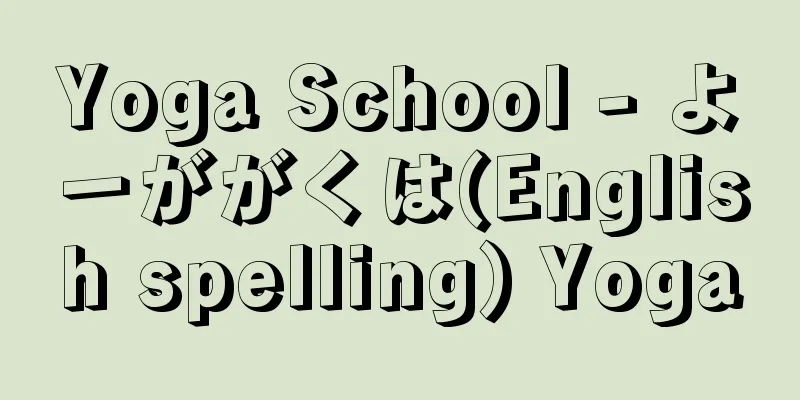Yoga School - よーががくは(English spelling) Yoga

|
One of the six schools of Indian philosophy. Yoga is said to have originated in the Indus civilization, but its practices were first explained in the mid-Buddhist Upanishads (books such as "Kata"). It has deep ideological ties with the Samkhya school, sharing its dualistic philosophy. Some traditions attribute the founder of this school to Hiranyagarbha (the Golden Womb), but it is generally believed to have been Patanjali, who wrote the fundamental sutra, "Yoga Sutra." This book, said to have been created around the 3rd to 5th century, summarizes the system of yoga while also being influenced by Buddhism and other sources. These include the Bhasya commentary by Vyāsa (5th-6th century), the Tattva Vaisāradhi commentary by Bhachaspati Mishra (9th century), the Rāja Mārtanda commentary by King Bhoja (11th century), and the Yoga Bārtika commentary by Vijnyānaviksh (16th century). The Yoga Sūtra first defines yoga as the cessation of the mind's activities, at which point the witness rests in the true nature of the true soul, the purusha. It then explains the activities of the mind and gives methods of training, which are summarized in the eight limbs of yoga: abstinence, observance of the precepts, sitting posture, control of the breath, control of the senses, retention (concentration), meditation, and samadhi. The five precepts are: not killing, truth, not stealing, chastity, and not acquiring anything. The five precepts are: abstinence, contentment, penance, recitation, and devotion to the Supreme Being. By observing these, one can regulate the breath, control the senses, concentrate and unify the mind, and finally realize the existence of the spiritual self that is separate from the workings of the mind and become at peace with the true nature of the spiritual self, which is called gedatsu (self-existence). [Murakami Makoto] "Religious Mysticism" by Hideo Kishimoto (1958, Daimeido)" ▽ "The Fundamental Scriptures of Yoga" by Yoshimi Matsuo (included in "World Masterpieces 1", 1969, Chuokoron-Shinsha)" ▽ "Commentary on Yoga Texts" by Kei Honda (1978, Heirakuji Shoten) [References] | | | |Source: Shogakukan Encyclopedia Nipponica About Encyclopedia Nipponica Information | Legend |
|
インド六派哲学の一つ。ヨーガの起源はインダス文明にあるといわれるが、その行法が説かれているのは、仏教以後の中期のウパニシャッド(『カタ』などの書)からである。サーンキヤ学派と思想的には深い関係を有し、その二元論的思想を共有する。この派の開祖をヒランヤガルバ(金胎(こんたい)神)に帰する伝承もあるが、通常はパタンジャリが開祖で、根本経典『ヨーガ・スートラ』を著したといわれる。3~5世紀ころにできたといわれるこの書は、仏教などの影響をも受けながら、ヨーガの体系をまとめたものである。これにはブヤーサVyāsa(5~6世紀)の注釈『バーシュヤ』、バーチャスパティ・ミシュラ(9世紀)の復注『タットバ・バイシャーラディー』、ボージャ王(11世紀)の注釈『ラージャ・マールタンダ』、ビジュニヤーナビクシュ(16世紀)の注釈『ヨーガ・バールティカ』などがある。『ヨーガ・スートラ』は、最初にヨーガを心の働きの停止と定義し、このときに観照者は真の霊魂プルシャ(霊我(れいが))の本性に安住するという。ついで心の働きを説明し、修行の方法を説くが、それはヨーガの八支にまとめられる。八支とは、禁戒、勧戒(かんかい)、坐法(ざほう)、呼吸の抑制、感官の制御、執持(しゅうじ)(集中)、静慮(じょうりょ)、三昧(さんまい)である。禁戒とは不殺生(ふせっしょう)、真実、不偸盗(ふちゅうとう)、貞潔、無所得の五戒。勧戒とは潔斎(けっさい)、満足、苦行、読誦(どくじゅ)、至上神への帰依(きえ)の五つ。これらを守って息を調え感官を制御し、心の集中、統一を行い、最後に、心の働きとは別な霊我の存在を知り、霊我の本性に安立することを解脱(げだつ)(独存)とする。 [村上真完] 『岸本英夫著『宗教神秘主義』(1958・大明堂)』▽『松尾義海著『ヨーガ根本聖典』(『世界の名著1』所収・1969・中央公論社)』▽『本多恵著『ヨーガ書註解』(1978・平楽寺書店)』 [参照項目] | | | |出典 小学館 日本大百科全書(ニッポニカ)日本大百科全書(ニッポニカ)について 情報 | 凡例 |
Recommend
Amogabajra - Amogabajra
Please see the "No Space" page. Source:...
Unwin, R.
… His proposal was seen by many as a utopian drea...
Full of lines - Full of lines
A collection of famous lines by actors. A small bo...
China Alliance - China Alliance
The first nationwide revolutionary political part...
Nazran' (English spelling)
…A republic in the North Caucasus of the Russian ...
Fated love - Unmeiaiai
Amor fati is a term used to describe the attitude ...
Isobutyric acid
An aliphatic carboxylic acid, an isomer of butyri...
Selling - Yobiuri
To walk around selling goods while shouting loudly...
The theory of evil people as the right machine
The fundamental thought of Shinran, the founder of...
Inamchi - Inamchi
…In Arabic it means a kind act or a donation, but...
Forest Conservation - Shinrinhogo
Preventing and eliminating forest disasters. This ...
Valentia
…Agricultural and industrial products are exporte...
Germany Year Zero - German Reinen
《Italy》 Germania Anno Zero 》An Italian film from 1...
Gansu Yangshao Culture (English: Gansu Yangshao Culture)
A Neolithic culture based on agriculture and anima...
Ota Dokan - Ota Dokan
A military commander in the mid-Muromachi period....






![Ellen [island] - Ellen](/upload/images/67cfafd93aba2.webp)


